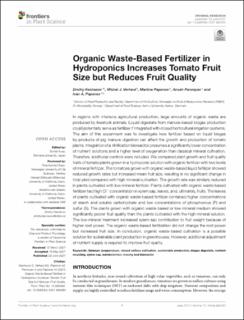| dc.contributor.author | Kechasov, Dmitry | |
| dc.contributor.author | Verheul, Michel | |
| dc.contributor.author | Paponov, Martina | |
| dc.contributor.author | Panosyan, Anush | |
| dc.contributor.author | Paponov, Ivan | |
| dc.date.accessioned | 2021-10-14T14:24:11Z | |
| dc.date.available | 2021-10-14T14:24:11Z | |
| dc.date.created | 2021-07-29T17:25:01Z | |
| dc.date.issued | 2021-06-23 | |
| dc.identifier.citation | Frontiers in Plant Science. 2021, 12 1-20. | en_US |
| dc.identifier.issn | 1664-462X | |
| dc.identifier.uri | https://hdl.handle.net/11250/2823120 | |
| dc.description.abstract | In regions with intensive agricultural production, large amounts of organic waste are produced by livestock animals. Liquid digestate from manure-based biogas production could potentially serve as fertilizer if integrated with closed horticultural irrigation systems. The aim of this experiment was to investigate how fertilizer based on liquid biogas by-products of pig manure digestion can affect the growth and production of tomato plants. Integration of a nitrification bioreactor presumes a significantly lower concentration of nutrient solutions and a higher level of oxygenation than classical mineral cultivation. Therefore, additional controls were included. We compared plant growth and fruit quality traits of tomato plants grown in a hydroponic solution with organic fertilizer with two levels of mineral fertilizer. The tomatoes grown with organic waste-based liquid fertilizer showed reduced growth rates but increased mean fruit size, resulting in no significant change in total yield compared with high-mineral cultivation. The growth rate was similarly reduced in plants cultivated with low-mineral fertilizer. Plants cultivated with organic waste-based fertilizer had high Cl− concentration in xylem sap, leaves, and, ultimately, fruits. The leaves of plants cultivated with organic waste-based fertilizer contained higher concentrations of starch and soluble carbohydrate and low concentrations of phosphorous (P) and sulfur (S). The plants grown with organic waste-based or low-mineral medium showed significantly poorer fruit quality than the plants cultivated with the high-mineral solution. The low-mineral treatment increased xylem sap contribution to fruit weight because of higher root power. The organic waste-based fertilization did not change the root power but increased fruit size. In conclusion, organic waste-based cultivation is a possible solution for sustainable plant production in greenhouses. However, additional adjustment of nutrient supply is required to improve fruit quality. | en_US |
| dc.language.iso | eng | en_US |
| dc.publisher | Frontiers Media S.A. | en_US |
| dc.rights | Navngivelse 4.0 Internasjonal | * |
| dc.rights.uri | http://creativecommons.org/licenses/by/4.0/deed.no | * |
| dc.title | Organic Waste-Based Fertilizer in Hydroponics Increases Tomato Fruit Size but Reduces Fruit Quality | en_US |
| dc.type | Peer reviewed | en_US |
| dc.type | Journal article | en_US |
| dc.description.version | publishedVersion | en_US |
| dc.rights.holder | © 2021 Kechasov, Verheul, Paponov, Panosyan and Paponov | en_US |
| dc.source.pagenumber | 1-20 | en_US |
| dc.source.volume | 12 | en_US |
| dc.source.journal | Frontiers in Plant Science | en_US |
| dc.identifier.doi | 10.3389/fpls.2021.680030 | |
| dc.identifier.cristin | 1923068 | |
| dc.relation.project | Norges forskningsråd: 255613 | en_US |
| dc.relation.project | EU/2018-1-NO01-KA107-038740 | en_US |
| dc.source.articlenumber | 680030 | en_US |
| cristin.ispublished | true | |
| cristin.fulltext | original | |
| cristin.qualitycode | 2 | |

